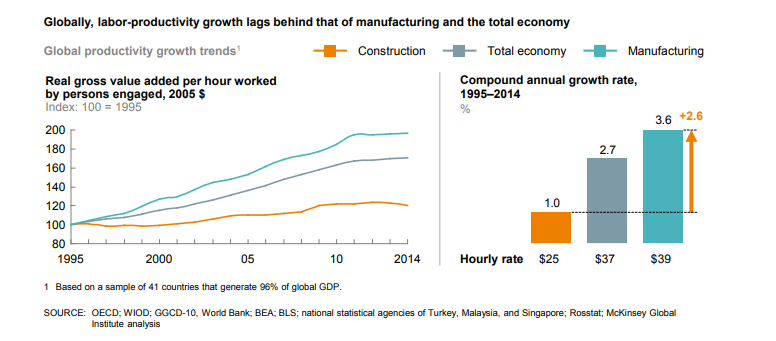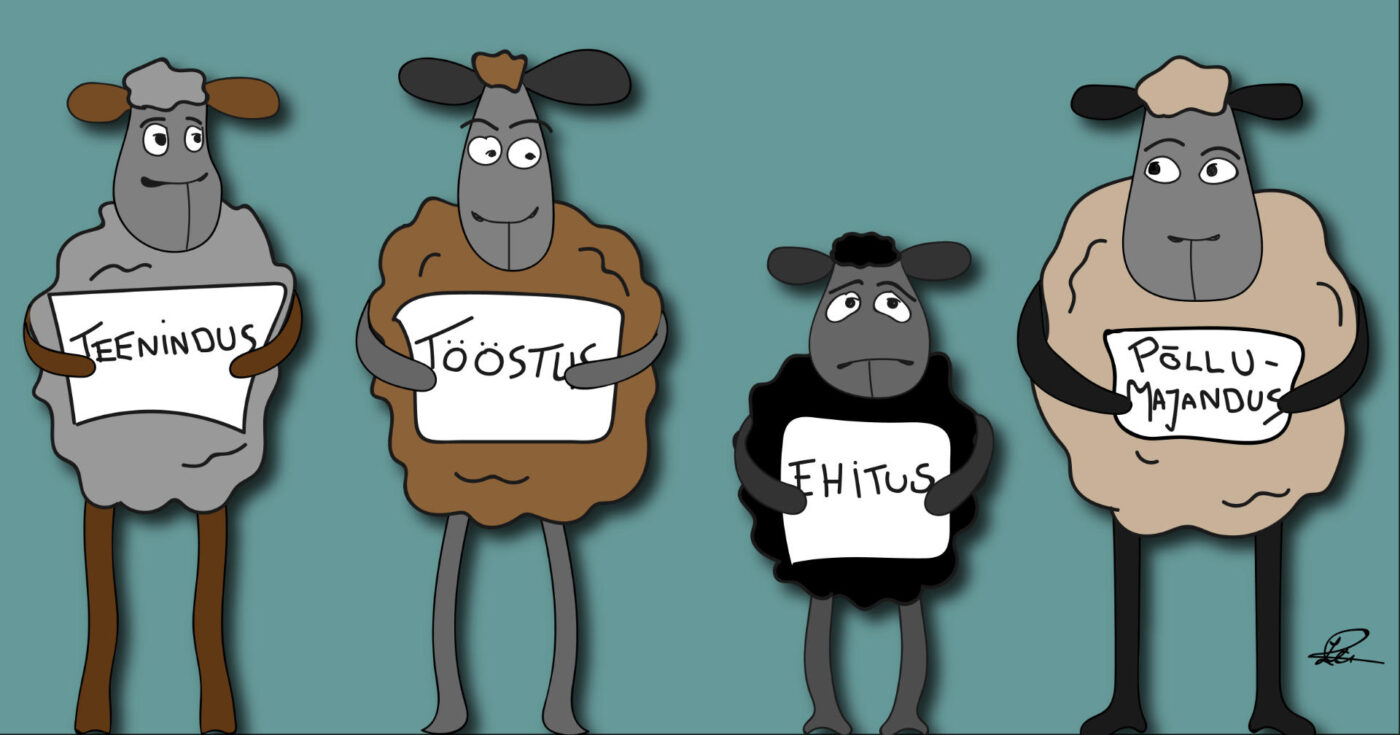Why has the construction sector lagged behind other sectors and what has Estonia done to change it?
Current situation in the construction sector
The construction sector is one of the biggest economic sectors in the world, providing work for nearly seven per cent of the global working-age population. Globally, about ten trillion dollars are spent on construction-based products and services^1.
As a result, the construction sector is also crucial for Estonia: through construction-related activities, companies in this field create wealth which accounts for approximately 6% and, combined with the real estate sector, 16% of the gross domestic product (GDP). The construction sector creates new jobs, supports the sustainable development of the economy, and through this, it is possible to address regional, social, climate, cultural heritage, and energy- related challenges^2.
However, the construction sector still faces a major problem, one with a global impact of trillions of dollars. This problem is low work efficiency.
The black sheep: the construction sector
The global construction sector has suffered from low productivity for decades. While other sectors have benefitted from innovation – digitisation, automation, global supply chains, standardisation, etc. – occurring during the past few decades, the productivity of the construction sector has not grown remarkably.
While the annual increase of the efficiency of the global economy has been about 2.8%, the productivity of the construction sector has risen by only a per cent per year. If we compare construction with agriculture, the annual increase in efficiency of which has been as much 3.8%, the construction sector can feel like the black sheep among the other sectors.^1

Our buildings have become smarter, higher in quality, more environmentally friendly. As a whole, people’s satisfaction with the condition of their dwellings has risen. On average, the satisfaction of Estonian residents has risen by 10% in ten years. However, methods from the 1950s are still used in the construction of buildings.^4
If the global construction sector were to catch up with other sectors in terms of efficiency, the benefits to the society would be remarkable. The expected increase in the added value of the sector would be as much as 1.6 trillion dollars! That is comparable, for example, with the annual gross domestic product of Canada. This change would add 2% to the annual global domestic product. ^1
From the Estonian perspective, the light can be seen at the end of the tunnel. The productivity of the Estonian construction sector has quickly risen during past few years: between 2015 and 2018, the productivity of the Estonian construction sector rose by 35%, which is a remarkable advancement, but still falls short of the European average. The added value has risen mainly in the special construction field, but also in the architect and engineering activities. It is also worth highlighting the successful export of wooden construction, in which we are by far the number one in Europe. However, the construction sector has lagged behind other sectors. ^5
E-construction platform and the vision for 2030
The Estonian construction sector has shown strong growth during the past few years. Between 2015 and 2018, the productivity of the Estonian construction sector rose by 35%, which is a remarkable advancement, but still falls short of the European average.
It is difficult to bring about big changes naturally within the sector – especially in a sector which operates according to old thought patterns and refuses to invest in future growth. However, the public sector, especially the Ministry of Economic Affairs and Communications, has stepped in to help. Their purpose is to bring about the needed paradigm shift, which would help to solve structural problems in the construction sector and therefore cause a growth in productivity. Hard work has been ongoing under the leadership of the ministry since 2018.
This year, the first document describing the change, ‘Vision of e-construction platform’, was published.
The main aim of the e-construction platform is enabling/helping to increase the productivity of the construction sector to the average level of the European Union, which means that productivity should grow at least threefold by 2030.
The vision includes principles, based on which it will be possible to achieve the goal successfully.
The essential principles are the following:
- Creating a digital twin of Estonia’s built environment, which will allow accessing all data connected to the building quickly, simply, and conveniently. With the twin, spatial planning will be brought to a
new level. New buildings can be fit into the surrounding environment and their possible impact can be analysed already in the planning stage. - All parties of the useful life of the building who are working toward a common goal are involved in the development, design, construction, and use of the building. The common goal is creating a site
with optimal costs over the whole useful life. For this purpose, the newest construction procurement and management processes are also implemented. (Alliance/automated design coordination working group) - Gathering, changing, and distributing information and data automatically during the construction process, without any additional manual work. This means that throughout the whole life of the building – from planning to demolition –, the creation, amendment, and mediation of data is partly automated.
- Communication with the state and local government is quick and efficient. It is possible for the parties of the public sector to assess the suitability of the building and its conformity to the requirements based on the information models, whereby parts of the assessment process takes place automatically, without the intervention of officials.
- Better availability of information makes the construction sector and process more transparent. Thanks to the data-based decision-making process, the quality of the decisions is enhanced.^6
These principles are just a basis for introducing changes. In reality, the changes happen only through changes in people’s thought patterns and hard work. For introducing and implementing these principles, the unique digital construction cluster has been created in Europe.
Digital construction cluster
As cooperation and a common understanding between the participants in various parts of the life of a building plays an important role in the development of the construction sector, the Estonian Digital Construction Cluster was created in 2014 under the leadership of the Ministry of Economic Affairs and Communications. The digital construction cluster currently includes 57 Estonian companies/organisations and 4 universities with the aim of digitising the Estonian construction sector.
The cluster organises workshops, conferences, study tours, and award galas with the aim of training and recognising companies engaged in the digitisation of construction. In addition, cluster meetings are also held every month. The aim of the vision/mission of the cluster is that the Estonian construction sector has a high reputation in society, that the sector knows its meaning and bears its
responsibility towards the development and future of society as a whole with dignity, that people in the construction sector work in trust, cooperation, and respect for each other, and that value is created in proven, efficient, and resource-conscious ways.
The cluster, in turn, has been divided into different working groups:
- The automated design coordination working group, the aim of which is analysing the principles of automated design coordination, adapting them to the Estonian market, and popularising this way of thinking. The leader of this working group is Tiit Hion from the partner company of the cluster, Hades Geodeesia.
- The BIM working group, the aim of which is unifying BIM requirements, standardising and localising software, and distributing the best practices of the model. The leader of this group is Miina Karafin from the partner company Nordecon.
- The export working group, the aim of which is enhancing the export capacity of cluster’s partners. The leader of this working group is Paavo Pärn from partner company Sirkel & Mall.
- The working group of cooperation with state and local governments, the aim of which is adapting and changing existing regulations and practices rooted in the construction sector and creating a new framework necessary for development. The leader of this working group is Tiit Hion from the partner company of the cluster Hades Geodeesia.
- The data working group, the aim of which is developing smart and value-creating solutions for using data in the construction sector. The leader of this group is Kristel Uibo from the cluster partner company Usesoft.
- The parametric design working group, the aim of which is finding and implementing automated solutions for routine work.
- The InfraBIM working group, the main aim of which is developing BIM capacity for infrastructure projects. The leader of this group is Kaisa Saarva from the partner company Reaalprojekt.
- The working group of culture and communication, the main aim of which is shaping the culture of the construction industry and introducing digital future possibilities to target groups and the general public. The leader of this group is Erkki Tuisk from the partner company Sirkel & Mall.
- The working group of material manufacturers, the main aim of which is helping construction material manufacturers join the digital world and making cooperation between them and other participants on the construction and real estate markets more efficient (digital).
What part does 3Di play in the development of the construction sector?
Two words play a central role in the development of the construction sector: data and cooperation. Changes have to work through the entire construction value chain, starting from the customer and ending with the subcontractor on the construction site. Change does not come from data alone; it also requires cooperation, trust, and a common understanding between companies. This is the only way we can catch up with other European countries in the development of our construction sector.
Being one of the leading companies in Estonia dealing with construction data, our aim is to make construction data visual and simply understandable, therefore helping to create trust in the entire value chain of construction. Our products help to make smarter decisions, reduce the number of construction mistakes, drive innovation in the construction value chain, and make the whole
construction process more efficient and transparent.
We believe that the construction value chain must realise that it is creating value for the common people on the street, at the office, at home. For our people to live and develop harmoniously, the living environment we create must support it – be of high quality. It is difficult to imagine that such a living environment could be created in mutual distrust and disrespect. Unfortunately, we have to say
that there is no trust between the parties. Parties often do not dare to disclose all of the information to each other, fearing that it may be used against them in contractual relations. Without mutual trust, information cannot be exchanged between the parties. If the exchange of data and information is hindered, it is also difficult to digitise data processes, not to mention material and value processes. This, in turn, hinders development and innovation in the entire construction value chain. Therefore, trust is of critical importance here. 3Di lays a foundation on which trust, innovation, as well as a common understanding about the value created together can be built.
3Di uses the latest data acquisition technologies in its work. We use different 3D scanners that enable us to collect data in different circumstances and for different purposes. We have developed a capable aerial fleet consisting of various drone platforms (UAVs) carrying cameras and Lidars or payloads for various purposes. These methods allow us to move from old-fashioned 2D to modern 3D. Three-dimensional data contains much more information than the traditional 2D data. With 3D data, it is possible to make models, drawings, and applications which are much more substantial, intuitive, and accurate than ever before.
3Di wants to be a pioneer in the creation and development of new opportunities in the entire field of construction.
Contact us and we take the next step in digitising construction together!
References:
1:McKinsey & Company: “Reinventing construction: A route to higher productivity” (2017)
2: Tartu Ülikooli sotsiaalteaduslike rakendusuuringute keskus RAKE: “Ehitussektori tootlikkuse, lisandväärtuse ja majandusmõju analüüs”(2018)
3: Revisions to labor-productivity metrics in the United States are ongoing; Leo Sveikauskas et al., “Productivity growth in construction,” Journal of Construction Engineering and Management, volume 142, issue 10, October 2016.
4: Eesti Statistika „Säästva arengu näitajad“ (2018)
5: Civitta: “Ehituse pikk vaade 2035” (2021)
6: Cvitta: “E-ehituse platvormi visioon” (2018)


